Eight Reales of Zacatecas, 1810-22
by Max A. Keech
Following the LVO style coinage Zacatecas would transition to a Provisional and then Standard Bust coinage. Zacatecas operated continuously from 1810-22 and was the most prolific of the branch mints of this era. Its eight reales coinage has always enjoyed popularity. A complete date set is obtainable but extremely challenging when grade is considered. There is also a number of major varieties for those wishing to expand their collecting interest.
The pages that follow include background on the key features of the War for Independence Eight reales of Zacatecas along with a listing of its major varieties.
Condition: For most War for Independence issues including the eight reales of Zacatecas, strike is the most important aspect of condition. A reasonably struck VF is often superior to a weakly struck AU. I have had Zacatecas eight reales that were uncirculated but so softly struck that the date was unreadable. As soon as this coin’s luster is gone, it becomes VG at best! Try to find a coin with a reasonable strike even if it is a lower technical grade. I have tried to describe what to expect for each date below.
Varieties: Major varieties known to me are listed below. This includes major varieties such as overdates and legend errors. Major varieties are produced from the use of a single error die and are generally very rare with less than ten examples known. Values will depend on how interesting the variety is, number known and condition. Varieties such as FERDIN VI (rather than VII) are especially desirable. In an unusual case, Krause cataloged the 1821 “full crown arc above shield” variety as a separate type, increasing its demand and value. I have not included minor varieties such as missing stops or minor variations in number/letter spacing or size. I am sure other major varieties exist and more will be discovered. Please let me know if you are aware of others and I will update variety information in the future.
Insurgent/Local Arms LVO Issues, 1810-11
After seizing Zacatecas on 30 October 1810, Insurgents under Capitan Iriarte struck their first coinage, the Insurgent/Local arms LVO issue. Coinage began on 26 November and continued through February 1811. A total of 171,379 pesos was struck in all denominations, most of which was coined in January-February 1811 as evidenced by the rarity of coins dated 1810.
| Obverse Design | Hills of La Bufa with cross in the foreground and El Grillo behind, atop L.V.O. with a semi-circular garland below, all surrounded by the Spanish legend “MONEDA PROVISIONAL DE ZACATECAS” beginning at nine o’clock. This represents the first use of a Spanish rather than Latin legend and the positioning is also novel. Dies were prepared using rudimentary local punches with some hand cutting. The result is crude yet ruggedly handsome |
| Reverse Design | Insurgent/Local coat of arms with pomegranates replacing lions and maguey in place of the pomegranate flanked by columns with ribbons surrounded by the Latin legend “FERDINANDUS. VII. DEI. GRATIA 8R. DATE. beginning at nine o’clock. Date reads in and castles are transposed with pomegranates. The plain ribbons do not contain a “PLUS ULTRA” inscription. |
| Edge Design | Plain edge. PCGS reports an 1810 LVO eight reales with a “Guadalajara edge”. The edge may be from striking over another coin or may have been applied after striking. An 1811 Royalist LVO eight reales with a colonial edge is also known. |
| Weight | Struck eight reales weights vary from 26.5 to 29 grams with most weighing more than 27 grams. Minors are proportional and generally over standard. These coins were favored in their day due to their weight and silver fineness which is near 100%! |
Struck 8 reales, Silver
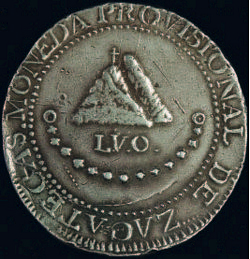
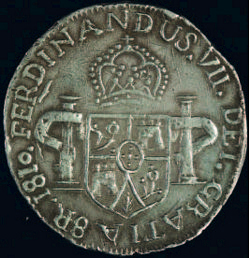
1810 Insurgent Arms LVO 8R
| 1810 | Date reads in. |
| Rarity | Rare with perhaps 20-30 collectible examples known. Crude VF is the norm with incomplete legends. A few examples exist in EF or slightly better. |
| 1811 | Date reads in. |
| Rarity | Scarce in crude VF-EF. Rare but obtainable in EF with nearly full legends. |
Royalist/Royal Arms LVO Issues 1811
The Royalists under Capitan Ochoa retook Zacatecas on 17 February 1811 and shortly after modified the offensive Insurgent/Local arms LVO design and began to strike coins. They would produce a total of 866,934 pesos of the Royalist/Royal arms redesign over the next six months before transitioning to a Provisional Armored Bust coinage in August 1811. The Royalist issues of 1811 at least ten times more plentiful than the Insurgent issues in spite of their 5:1 mintage ratio. This is possibly due to the Insurgent/Local arms LVO’s being melted in higher percentages due to their higher silver content.
| Obverse Design | Hills of La Bufa in foreground and El Grillo with cross behind, atop L.V.O. with a semi-circular garland below, all surrounded by the legend “MONEDA PROVISIONAL DE ZACATECAS” beginning at twelve o’clock. This differs from the Insurgent/Local arms in the location of the cross and legends. The Royalist/Royal arms dies are better engraved with superior punches then the Insurgent/Local arms type and planchet/striking quality tends to be a little better. |
| Reverse Design | Correct Royal coat of arms with lions and pomegranate in proper position, flanked by columns with ribbons surrounded by the legend “FERDIN. VII. DEI. GRATIA 8R. 1811.” beginning at six o’clock. This differs from the Insurgent/Local arms in the location of the legend, abbreviation of FERNANDUS and date reading out rather than in. The motto PLUS ULTRA has also been restored to the ribbons. |
| Edge Design | Plain edge. An example is known with a colonial edge which appears to have been applied after striking. |
| Weight | Struck 8 reales weights vary from 26.5 to 29 grams with most weighing more than 27 grams. Minors areproportional and generally over standard. |
Struck 8 reales, Silver
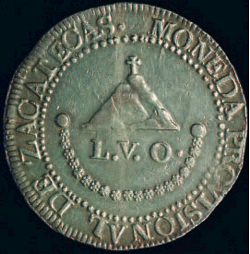
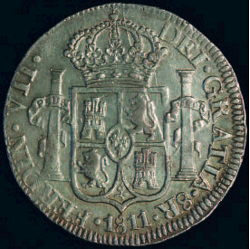
1811 Royalist Arms LVO 8R
| 1810 | Date reads out. |
| Rarity | Somewhat common but scarce in EF or better with complete legends. A nice EF-AU is obtainable with patience. Ten times more plentiful than the Insurgent/Local arms eight reales of 1811. |
| Varieties | a. FERDIN. VI rather than VII b. L.V.O. missing |
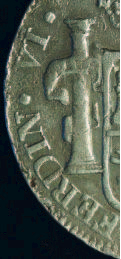
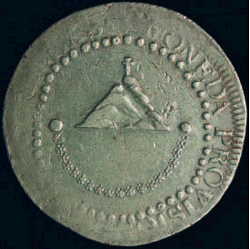
FERDIN. VI L.V.O. missing
Muling of Insurgent/local & Royalist/Royal Arms Dies
A very rare muling of Insurgent/Local arms and Royalist/Royal arms dies was struck sometime in 1811. A somewhat marred Insurgent/Local arms obverse die was paired with a Royalist/Royal arms reverse die to strike this coin. It is unusual and unique in combining an Insurgent and Royalist design on one coin! The most probable explanation is a transitional coinage where the Royalists first corrected the royal arms on the offensive reverse die and struck coins before an obverse die was prepared. This would make it the first Royalist coinage at Zacatecas. It is instantly recognizable by the obverse legend starting at nine o’clock coupled with the Royal arms on the reverse.
Struck 8 reales, Silver
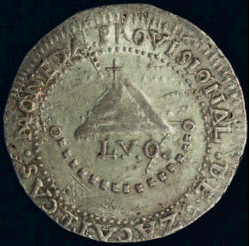

1811 Insurgent/Royalist Mule 8R
| 1810 | Insurgent/Local arms obverse and Royalist/Royal arms reverse dies |
| Rarity | Very rare with less than ten specimens known. Most are in the VF range and are often impaired. |
Contemporary Counterfeits (Local Dies)
The 1811 Royalist/Royal arms LVO was widely counterfeited as noted by several contemporary sources discussed in the March 2021 article. One report suggested Insurgents were responsible for this counterfeiting. Importantly, these contemporary counterfeits circulated widely and were often validated by Insurgent authorities for local use! The legends are crude on these imitations and will generally stand out, some more than others. A few of the best counterstamp examples found are on contemporary counterfeits and these pieces have been plated in key references such as Dasí, Burzio and Krause. For these reasons they are as collectible as the official issues themselves. Many past authorities and auction houses have referred to them as “Local Dies” perhaps to avoid the negative associated with the word counterfeit. Given that the vast majority of all genuine pieces weigh in excess of 27 grams, anything under 26.5 grams is suspect. Surprisingly, contemporary counterfeits of the Insurgent dies are not encountered.
Struck 8 reales, Silver
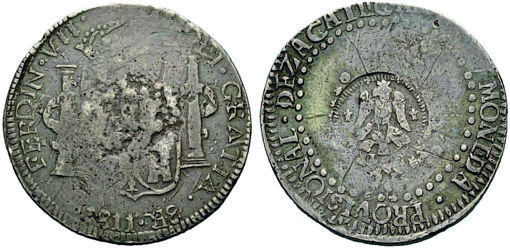
1811 Counterfeit 8R with NORTE MNL counterstamp,
Dasí, Pradeau, & KM plate, 24.4 gm.
| 1811 | Royalist/Royal arms contemporary counterfeit |
| Rarity | Common but very scarce in undamaged VF or better. Values are similar to genuine examples of similar grade, strike and detail but the imitations will rarely be found well struck. Examples with Insurgent counterstamps trade at indistinguishable levels from those on genuine hosts. The counterstamps most often encountered on these contemporary counterfeits are Morelos, Ensaie and JML demonstrating that these were generally allowed to circulate in Insurgent territory. They were certainly superior to the copper issues! |
| Varieties | While each counterfeit die pair could be considered a variety, a few of the notable examples encountered include; a. Single mountain b. Stick style lettering c. 1181 date d. Retro 1s in date |
Provisional Armored Bust, 1811-12
In August 1811 the Royalists substituted the Provisional Armored Bust design for the LVO series which had been discredited by its Insurgent origins. Inexplicitly, production quality actually declined from that achieved with the LVO coinage.
| Obverse Design | “-FERDIN-VII-8R- || DEI-GRATIA-II DATE” (Ferdinand VII by the Grace of God) surrounding an armored bust of Ferdinand VII facing right. |
| Reverse Design | “MONEDA PROVISIONAL DE ZACATECAS” (Provisional Money of Zacatecas) surrounding the crowned arms of Castile and Leon quartered with a pomegranate below and three fleurs de lis in center flanked by columns (of Gibraltar) with ribbons “PLUS” “ULTRA” (More beyond) |
| Edge Design | Plain edge. |
| Weight | Struck eight reales generally vary between 26.5 to 27.1 grams with minors proportional. |
Struck 8 reales, Silver
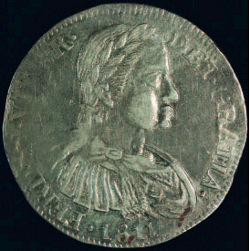

1811 Provisional Armored Bust 8R
| 1811 | Crude die work and uneven strikes is the norm. The collector will need to choose between readable legends or a reasonable bust and shield. |
| Rarity | The 1811 is available in weakly struck grades of G-F. Rare in nice VF or better with more than 50% legends. The 1811 is twice as available as the 1812. At least one example is known struck over a Sombrerete eight reales. |
| Varieties | Examples with an obverse die break are sometimes misdescribed as 1811/0 a. Error obverse legend “FERDIN.VI.” |
| 1812 | All examples are unevenly struck |
| Rarity | Very Rare in reasonably struck F or better with 50% legends. |
Provisional Draped Bust, 1812
Late in 1812 a Provisional Draped Bust design was introduced for the coinage of eight reales. This design change was not made for minor coinage. The denomination 8R is moved from the obverse to the reverse. Production quality is very poor showing a continued decline from the preceding Provisional Armored Bust coinage.
| Obverse Design | “-FERDIN-VII- || DEI-GRATIA-II DATE” (Ferdinand VII by the Grace of God) surrounding an armored bust of Ferdinand VII facing right. |
| Reverse Design | “MONEDA PROVISIONAL DE ZACATECAS-8R-” (Provisional Money of Zacatecas 8R) surrounding the crowned arms of Castile and Leon quartered with a pomegranate below and three fleurs de lis in center flanked by columns (of Gibraltar) with ribbons “PLUS” “ULTRA” (More beyond). |
| Edge Design | Plain edge. |
| Weight | Struck eight reales generally vary a little more than the Provisional Armored Bust type with examples seen between 25.8 and 27.1 grams. |
Struck 8 reales, Silver
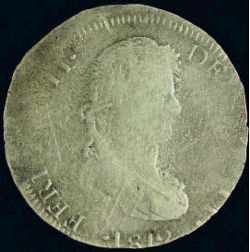
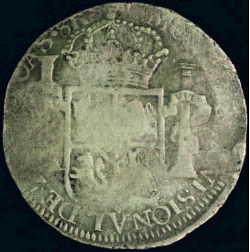
1812 Provisional Draped Bust 8R
| 1812 | All specimens exhibit very poor striking quality resulting in incomplete legends, bust and shield even on the finest examples known. The Provisional Draped Bust coinage is rarer than the 1811-12 Provisional Armored Bust type. The Zacatecas mint hits rock bottom in quality with this issue. |
| Rarity | Any example with more than 50% of the coin readable is rare. No examples are nicely struck or fully readable! |
| Varieties | a. Retro D’s in reverse legend |
Standard Draped Laureate Bust, 1813-22
In 1813 a standard Draped Laureate Bust design was instituted for the eight reales while the minor coinage utilized an Armored Bust design. Minor coinage would not transition to a Draped Laureate Bust until 1818 to 1820.
| Obverse Design | “FERDIN-VII- || DEI-GRATIA-II DATE-” (Ferdinand VII by the Grace of God) surrounding a draped, laureate bust of Ferdinand VII facing right. |
| Reverse Design | “-HISPAN-ET-IND-REX-Zs-DENOM-Ass-”(King of Spain and of the Indies) surrounding the crowned arms of Castile and Leon quartered with a pomegranate below and three fleurs de lis in center flanked by columns (of Gibraltar) with ribbons “PLUS” “ULTRA” (More beyond). |
| Edge Design | Struck eight reales begin under Assayer FP with a plain edge in 1813-14. In early 1814 Assayer AG initiated a standard colonial edge. |
| Weight | Struck eight reales vary between 25.5 and 27.1 grams with minors proportional. Most examples are light with eight reales averaging around 26.3 grams thru 1818 and 26.8 grams after. |
Struck 8 Reales, Silver
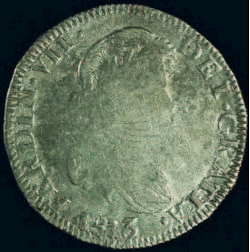

1813FP Standard Draped Laureate Bust 8R
| 1813 FP | The standard Draped Laureate Bust issue begins in 1813 with a plain edge. Struck quality is terrible for the period 1813 thru 1815 with virtual all examples displaying very weak centers. Quality improves significantly in 1816. |
| Rarity | Very rare with readable legends and bust/shield. A net F with weak centers and readable legends is the best available. |
| Varieties | The I punch has a chipped foot which should not be mistaken for a retro 1. This punch is used through 1815. |
| 1814 FP | Rare assayer unlisted in Calbeto. Plain edge. All examples are poorly struck. |
| Rarity | Rare in any condition. A good-very good with weak centers and readable legends is a prize. |
| Varieties | a. D/retro D in reverse legend |
| 1814 AG | In 1814 new Assayer AG introduces a colonial edge. All examples are poorly struck. |
| Rarity | Very rare with readable legends and bust/shield. A F with weak centers and readable legends is the best available. |
| Varieties | a. Assayer AG/FP |
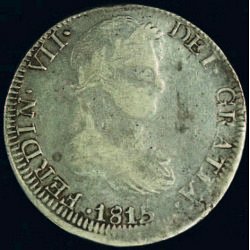

1815AG Standard Draped Laureate Bust 8R
| 1815 AG | Colonial edge. Quality is somewhat improved from 1814 but all examples are poorly struck |
| Rarity | Very rare with readable legends and bust/shield. A F to aVF with weak centers and readable legends is the best available. |
| 1816 AG | Quality improves dramatically in 1816. Examples can be found with complete legends, bust and shield, however they are never fully struck up. |
| Rarity | Common in grades of VG-VF. EF is obtainable and anything nicer is rare. |
| Varieties | a. 1816/5 b. Obverse error legend “FERDID |

FERDID error legend
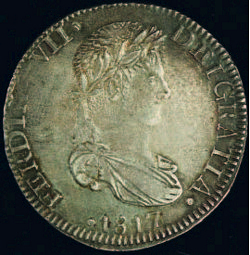
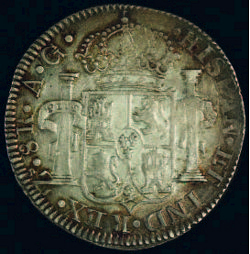
1817AG Standard Draped Laureate Bust 8R
| 1817 AG | The striking improvements that began in 1816 continue in 1817. Fully struck coins are available. |
| Rarity | Common in grades thru EF-AU. Uncirculated specimens are available on occasion. |
| Varieties | a. Inverted Fleur de lis b. Obverse error legend “HIS/IP/IAN” |
| 1818 AG | Beginning in 1818 production increases significantly and the number of varieties explodes. |
| Rarity | Common but very scarce in nice AU-UNC. |
| Varieties | a. 1818 double date (no stop after REX) b. 1818/7 c. Horizontal s in mintmark Zs d. Obverse error legend “FERDI” missing N e. Obverse error legend “FERDIE” f. Obverse error legend “FERDIN/D” g. Obverse error legend “FERDI/JN h. Obverse error legend “DEI” i. Obverse error legend “VII” with inverted A |

FERDI error legend
1818 Double Date

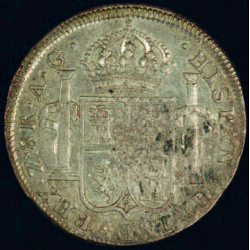
1819AG Standard Draped Laureate Bust 8R
| 1819 AG | A new bust type is introduced in 1819 which has a more mature, Roman look. Legend lettering is also more uniform and die pressure appears to increase. Better quality control results in less major varieties. From 1819 thru 1822 fully struck, near mint state to mint state examples can be found on occasion. |
| Rarity | Common but scarce in nice AU-UNC |
| Varieties | a. 1819/9181 b. Obverse error legend “GRATA” c. Obverse error legend “VII” with inverted A |
| 1820 AG | Quality control continues to improve from 1820-22 and few significant varieties are seen. Minor varieties such as missing stops still occur |
| Rarity | Common but scarce in nice AU-UNC. |
| Varieties | a. Closely spaced date |
>
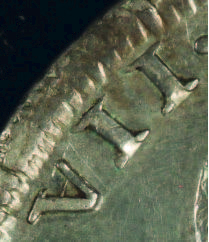
GRATA error legend VII with inverted A
| 1820 AG | It appears Assayer RG replaced AG late in 1820 based on relative scarcity. Assayer AG eight reales are three to four times more available that those of Assayer RG. |
| Rarity | Somewhat scarce and rare in nice AU-UNC. |
| Varieties | a. Small bust, 28 vs 31 mm high |
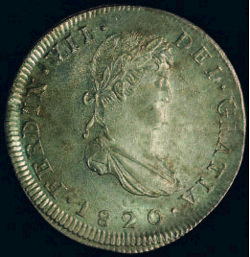
Small Bust, 28 vs. 31mm high
| 1821 RG | The Zacatecas 1821 RG eight reales is the most common coin struck at Royalist branch mints during the War for Independence. Its population is about equivalent to all other branch mint eight reales combined! It is a ‘frozen date” that Zacatecas continued to strike after Mexico City officials pressured them to discontinue Royalist Bust style coinage in 1822 following Independence and the advent of Iturbide’s rule. By striking 1821 dated Royalist coinage, the eight reales carried a date prior to Independence and their seditious nature was deniable. Zacatecas continued the use of 1821 dated dies until 1825 when the Spanish were finally expelled from Mexico and Zacatecas began striking the Cap and Rays type eight reales. |
| Rarity | Very common, it is encountered about ten times more frequently than other Zacatecas eight reales dated between 1816 and 1822. Available in fully struck UNC. |
| Varieties | a. Full crown arc above shield (Di Sotto In Su) (separate type coin in Krause catalogs) b. 1821 over inverted 1821 c. Error reverse legend “8s R” d. Error obverse legend “HISAV” |
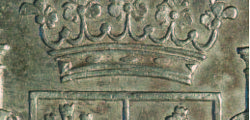

Regular & Full Crown Arc above shield
| 1821 AZ | Assayer AZ coins are somewhat scarce and similar in availability to the 1820 RG and 1822 RG. |
| Rarity | Somewhat scarce and rare in nice AU-UNC. |
| Varieties | a. AZ/RG |
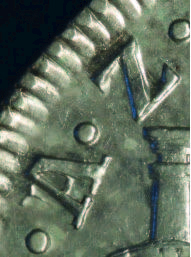
AZ/RG over Assayer
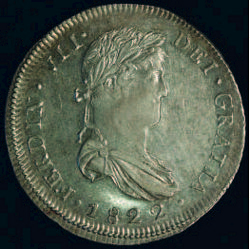
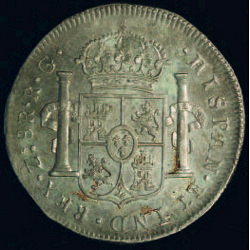
1822RG Standard Draped Laureate bust 8R
| 1822 RG | Mexican independence was declared on 28 September 1821 and Iturbide’s imperial rule began in May 1822. Striking of the 1822 Draped Bust issue continued after Iturbide Imperial coinage began in mid-1822. There is evidence that Zacatecas mint officials were pressured to discontinue use of these Royal dies, which they did making the 1822 somewhat scarce. Rather than entirely discontinue minting eight reales, mint officials simply reverted to the use of the 1821 RG dies which were arguably a colonial era coinage. |
| Rarity | Available in EF but rare in nice AU-UNC. |
